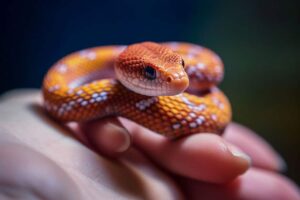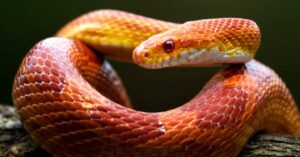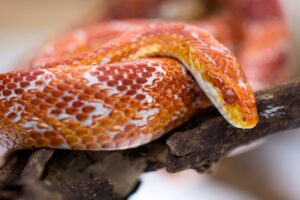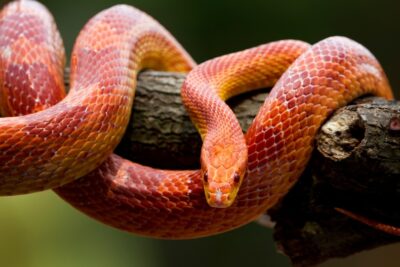Do corn snakes burrow? This is a question that frequently crosses the minds of snake enthusiasts and curious minds alike. Corn snakes (Pantherophis guttatus), renowned for their vibrant colors and docile nature, are a popular choice among reptile enthusiasts.
These non-venomous colubrids, native to North America, have captivated the hearts of snake enthusiasts for decades. While their natural behaviors and habitats have been extensively studied, a common question arises among snake keepers and curious minds alike: do corn snakes burrow?
Do corn snakes naturally burrow?

Corn snakes (Pantherophis guttatus) are not known for being burrowers in the wild. Instead, they are commonly found in a variety of habitats, including grasslands, forests, and abandoned buildings. These snakes are skilled climbers and are often observed in trees or shrubs, where they hunt for prey.
In captivity, corn snakes typically do not exhibit strong burrowing behavior either. However, providing them with appropriate substrate, such as aspen shavings or cypress mulch, allows them to engage in natural behaviors like exploring, hiding, and thermoregulating by burrowing to some extent.
It’s essential to provide a suitable hiding place in their enclosure to make them feel secure, but deep burrowing is not a characteristic behavior for corn snakes in general.
Why do corn snakes burrow?
Corn snakes, like many other snake species, may burrow for several reasons:
- Temperature Regulation: Burrowing allows snakes to regulate their body temperature. By going underground, they can escape extreme temperatures and find a more stable and comfortable environment. This behavior is particularly important for ectothermic animals like snakes, as they rely on external sources of heat to regulate their body temperature.
- Safety and Security: Burrowing provides a sense of safety and security. Snakes are generally shy and solitary animals, and burrows offer them a hidden space where they can feel protected from predators and disturbances.
- Hunting and Ambushing Prey: Snakes are ambush predators, and some species, including corn snakes, may use burrows as a strategic location to wait for prey to pass by. They can then strike quickly and efficiently.
- Molting: Snakes shed their skin periodically as they grow, a process known as molting. Burrows offer a protected space for snakes to complete the shedding process without being vulnerable to predators. The humidity in burrows can also aid in the shedding process.
- Nesting and Reproduction: Female snakes may use burrows for nesting and laying eggs. The burrow provides a secure location for the eggs, protecting them from potential threats.
It’s important to note that while some corn snakes may burrow, others may exhibit different behaviors based on their individual personalities, environmental conditions, and the availability of suitable burrowing sites.
Providing a captive corn snake with a proper enclosure that includes hiding spots can mimic the natural behavior of burrowing and contribute to the snake’s overall well-being.
How deep do corn snakes burrow in captivity?
Corn snakes are not known for extensive burrowing behavior in captivity. In the wild, they may use burrows or hide in underground spaces, but their captive environment typically includes a substrate (such as aspen shavings, cypress mulch, or coconut coir) that allows for burrowing to a limited extent. In captivity, corn snakes often prefer to hide in snug spaces or underneath objects rather than burrow extensively.
Providing a substrate layer in their enclosure allows them to engage in natural behaviors, including burrowing or creating tunnels. However, the depth of burrowing may vary from one individual snake to another, and not all corn snakes will exhibit this behavior.
It’s essential to monitor your snake’s behavior and preferences to ensure they have a comfortable and enriching environment. Additionally, make sure the substrate is kept clean and that it provides a suitable environment for maintaining proper humidity levels, as corn snakes, like many reptiles, require specific environmental conditions for their well-being.
Best substrate for corn snakes burrowing
Corn snakes benefit from substrates that allow for burrowing while also maintaining appropriate humidity levels. Here are some commonly used substrates for corn snakes:
- Aspen Bedding: Aspen shavings are a popular choice for corn snakes. They are easy to clean and provide a substrate that allows for burrowing.
- Cypress Mulch: Cypress mulch is another suitable option. It holds moisture well and provides a naturalistic environment for the snake. Make sure to choose a brand that is free of any additives or chemicals.
- Coconut Coir: Coconut coir or coconut husk is a natural substrate that retains moisture and allows for burrowing. It’s also environmentally friendly.
- Paper-Based Substrates: Some keepers use paper-based substrates like shredded newspaper or paper towels. While these don’t allow for burrowing, they are easy to clean and replace.
- Bioactive Substrates: For a more naturalistic setup, some keepers use bioactive substrates that include a mix of organic materials like coconut coir, sphagnum moss, and leaf litter. These setups may include live plants and beneficial microorganisms.
Regardless of the substrate you choose, ensure that it is safe, free of pesticides or chemicals, and provides a comfortable environment for your corn snake. Regular spot cleaning and substrate changes will help maintain a clean and healthy enclosure for your snake.
Additionally, you need to monitor humidity levels to ensure they fall within the appropriate range for corn snakes, which is typically around 40-60%.
Signs of burrow for corn snakes

Creating a suitable burrow or hiding spot for a corn snake in captivity is essential to mimic its natural environment and provide a sense of security.
Here are some signs or elements you can incorporate into the enclosure to create a comfortable hiding spot for your corn snake:
- Hide Boxes:
- Provide at least two hide boxes, one on the warm side and one on the cool side of the enclosure.
- Use commercially available reptile hides or create your own using materials like plastic containers with entrance holes.
- Substrate:
- Choose a substrate that allows for burrowing. Aspen shavings, cypress mulch, or coconut coir are good choices.
- Provide a layer deep enough for the snake to burrow and feel secure.
- Cork Bark or Half-Logs:
- Add cork bark or half-logs in the enclosure, creating natural hiding spots.
- These items provide secure spaces for the snake to crawl under or climb on.
- Artificial Plants:
- Silk or plastic plants can be used to create additional hiding spots.
- These not only serve as decor but also provide cover for the snake.
- Stacked Stones or Hides:
- Arrange flat stones or hides in a way that creates small, snug spaces for the snake to hide.
- Ensure the stones or hides are stable and won’t collapse.
- Temperature and Lighting:
- Ensure the temperature and lighting in the hide are appropriate. Corn snakes prefer warmer hides, so use a heat pad or lamp to maintain proper temperatures.
- Multiple Levels:
- If the enclosure allows, create different levels with hides on different heights to encourage exploration.
- Monitoring Behavior:
- Observe your snake’s behavior. If it consistently chooses one hide over another, you can adjust the environment to better suit its preferences.
Remember that while it’s essential to provide hiding spots, it’s equally important to monitor your snake’s health and behavior. If the snake consistently refuses to eat, displays signs of stress, or shows any unusual behavior, consult with a veterinarian or reptile expert for guidance on adjusting the enclosure setup.
Does enclosure type affect burrowing?
Yes, the type of enclosure you choose for your corn snake can significantly affect its burrowing behavior. Different enclosure types provide varying opportunities for burrowing and hiding, and the choice depends on the natural habits of corn snakes and their need for security.
Here are some common enclosure types and their impact on burrowing:
- Glass Terrariums:
-
- Glass enclosures are popular choices for reptile keepers because they provide a clear view of the snake.
- To facilitate burrowing, you can use a substrate like aspen shavings, cypress mulch, or coconut coir. Create a deep layer to allow the snake to burrow comfortably.
- Plastic Tubs or Racks:
-
- Some keepers use plastic tubs or racks as enclosures for corn snakes, especially for breeding projects or to create a simple and secure environment.
- These setups can be filled with suitable substrate for burrowing. Ensure that the tub is appropriately sized to allow for burrowing behavior.
- Naturalistic Vivariums:
-
- Vivariums aim to replicate a natural environment with live plants, branches, and substrate. This type of enclosure encourages natural behaviors, including burrowing.
- Incorporate a mix of substrate, hides, and other elements that mimic the snake’s natural habitat.
- Custom Enclosures:
-
- Some reptile keepers prefer to build custom enclosures to meet the specific needs of their corn snakes.
- Custom enclosures can include features like built-in hides, burrows, and climbing structures, providing a more tailored environment.
- Bioactive Setups:
-
- Bioactive enclosures involve the use of live plants, beneficial microorganisms, and a self-sustaining ecosystem.
- These setups can promote natural behaviors, including burrowing, as the substrate is often deep and enriched with organic matter.
Regardless of the type of enclosure, it’s crucial to monitor the snake’s behavior and make adjustments as needed. If your corn snake shows a preference for burrowing or hiding in specific areas, ensure that those areas are adequately provided with substrate and hiding spots. Regularly check and clean the enclosure to maintain a healthy and comfortable environment for your snake.

Differences in juvenile and adult corn snakes burrowing
Juvenile and adult corn snakes may exhibit differences in their burrowing behaviors, and these variations are often influenced by factors such as size, age, and natural instincts.
Here are some general differences you might observe in the burrowing behavior of juvenile and adult corn snakes:
Juvenile Corn Snakes:
- Size and Space:
- Juveniles are smaller in size, and their burrowing needs may differ from adults.
- They may prefer shallower burrows or hide in smaller, more confined spaces.
- Exploration:
- Juveniles are typically more curious and may spend more time exploring their surroundings.
- They may utilize burrows as a form of exploration and play, in addition to seeking security.
- Frequent Hiding:
- Young snakes may be more skittish and prone to hiding more frequently than adults.
- Adequate hiding spots, including burrows, are essential for reducing stress in juvenile corn snakes.
- Temperature Regulation:
- Juveniles may burrow to find optimal temperature gradients within the enclosure for thermoregulation.
Adult Corn Snakes:
- Size and Strength:
- Adult corn snakes are larger and more powerful, requiring more substantial hiding spots.
- They may create deeper and more extensive burrows compared to juveniles.
- Security and Resting:
- Adults are more likely to use burrows primarily for security and resting purposes.
- Burrowing becomes a crucial aspect of their natural behavior, providing a sense of safety.
- Territorial Behavior:
- Adults may exhibit more territorial behavior, and their burrows may serve as personal spaces within the enclosure.
- Reduced Exploration:
- While adults may still explore their surroundings, they tend to be more settled and may not actively seek out new hiding spots as often as juveniles.
General Considerations:
- Substrate Depth:
- Regardless of age, providing a deep layer of suitable substrate allows both juvenile and adult corn snakes to engage in burrowing behavior.
- Hides and Structures:
- Ensure that the enclosure has appropriately sized hides and structures for the snake’s size and age.
- Incorporate various hiding spots, including burrows, to accommodate the snake’s preferences.
- Observation:
- Regularly observe your corn snake’s behavior to understand its preferences and adjust the enclosure accordingly.
Remember that individual snakes may have unique personalities, and preferences for burrowing can vary. Providing a range of hiding options and substrate choices ensures that your corn snake can engage in natural behaviors at any stage of its life.
Role of temperature and humidity in corn snake burrowing
Temperature and humidity play crucial roles in the burrowing behavior and overall well-being of corn snakes. In their natural habitat, corn snakes are found in a variety of environments, from forests to grasslands, and their burrowing habits are influenced by the need for thermoregulation and moisture regulation.
Here’s how temperature and humidity impact corn snake burrowing:
Temperature:
- Thermoregulation:
- Corn snakes are ectothermic, meaning they rely on external heat sources to regulate their body temperature.
- Burrowing allows them to find optimal temperature gradients within their environment. A temperature gradient in the enclosure, with a warm side and a cooler side, encourages natural behaviors, including burrowing.
- Behavioral Cues:
- Snakes may burrow to escape excessive heat or cool down, depending on their body temperature.
- Proper temperature gradients are essential to allow the snake to move between warmer and cooler areas, promoting natural behaviors, including burrowing.
Humidity:
- Hydration:
- Burrowing can help corn snakes conserve moisture and regulate hydration levels.
- Adequate humidity is essential, especially during shedding, as it helps the snake shed its skin more easily. Burrowing into damp substrate aids in maintaining appropriate skin hydration.
- Behavioral Responses:
- Corn snakes may burrow to find areas of higher humidity when needed.
- Maintaining a humidity level appropriate for the species helps support the snake’s respiratory health and overall well-being.
- Preventing Dehydration:
- In drier environments, burrowing can serve as a protective measure against dehydration. Burrowing into the substrate helps snakes avoid desiccation and maintain adequate moisture levels.
Considerations for Enclosure Setup:
- Substrate Choice:
- Choose a substrate that retains moisture well, such as aspen shavings, cypress mulch, or coconut coir. This provides a suitable environment for burrowing and helps maintain humidity levels.
- Hide Boxes:
- Provide hiding spots and hide boxes on both the warm and cool sides of the enclosure. These should be appropriately positioned to allow the snake to choose the preferred temperature and humidity levels.
- Temperature Gradient:
- Use heating elements like heat pads or lamps to create a temperature gradient within the enclosure, with a warm side and a cooler side.
- Provide a temperature range that allows the snake to regulate its body temperature through burrowing.
- Humidity Control:
- Monitor and control humidity levels within the enclosure, especially during shedding periods.
- Use a hygrometer to measure humidity and adjust accordingly. This can involve misting the enclosure or using a humidity-friendly substrate.
By paying attention to the temperature and humidity needs of corn snakes and providing an appropriate environment, you can encourage natural burrowing behaviors and contribute to the overall health and well-being of your pet snake.
Regular monitoring and adjustment of these environmental factors are key to maintaining a comfortable and enriching habitat for your corn snake.
Conclusion
This page gives all you need to know on the question do corn snakes burrow. Corn snakes do exhibit burrowing behavior. Burrowing serves various purposes for these reptiles, including thermoregulation, hydration, security, and natural exploration.
Providing suitable substrate, temperature gradients, and hiding spots in their enclosure is essential to support and encourage this natural behavior throughout their lives. Understanding and catering to the burrowing instincts of corn snakes contribute to their overall well-being in captivity.

